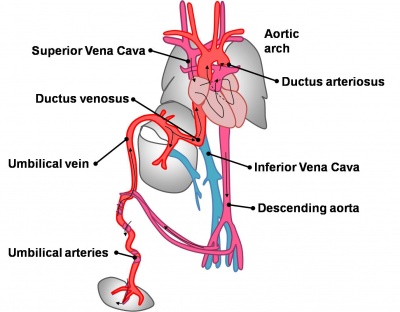Introduction
Fetal circulation differs from the adult predominantly due to the presence of 3 vascular shunts located within the heart and in the vasculature.
- Foramen ovale - in the heart, between the right and left atrium.
- Ductus venosus - in the liver circulation, between the umbilical vein and IVC
- Ductus arteriosus - in the outflow tract, between the pulmonary artery and descending aorta.
Some Recent Findings
- Endothelial cell lineages of the heart. [1] "During early gastrulation, vertebrate embryos begin to produce endothelial cells (ECs) from the mesoderm. ECs first form primitive vascular plexus de novo and later differentiate into arterial, venous, capillary, and lymphatic ECs. In the heart, the five distinct EC types (endocardial, coronary arterial, venous, capillary, and lymphatic) have distinct phenotypes. For example, coronary ECs establish a typical vessel network throughout the myocardium, whereas endocardial ECs form a large epithelial sheet with no angiogenic sprouting into the myocardium. Neither coronary arteries, veins, and capillaries, nor lymphatic vessels fuse with the endocardium or open to the heart chamber. The developmental stage during which the specific phenotype of each cardiac EC type is determined remains unclear. The mechanisms involved in EC commitment and diversity can however be more precisely defined by tracking the migratory patterns and lineage decisions of the precursors of cardiac ECs."
|
References
- ↑ <pubmed>18682987</pubmed>
Reviews
<pubmed></pubmed>
<pubmed></pubmed>
<pubmed></pubmed>
<pubmed></pubmed>
<pubmed></pubmed>
Articles
<pubmed></pubmed>
<pubmed></pubmed>
<pubmed></pubmed>
<pubmed></pubmed>
<pubmed></pubmed>
Search Pubmed
Search Pubmed: Cardiovascular Fetal Shunt
